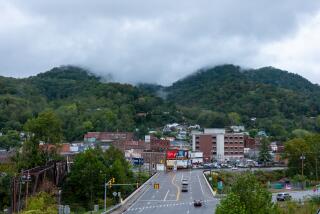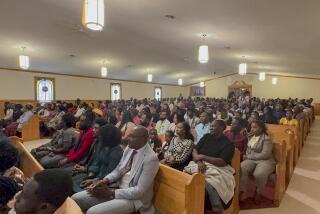Urban Appalachians Find Pride in Hillbilly Heritage
- Share via
CINCINNATI — It’s been almost 30 years since Debra Holmes quit going to classes at her Cincinnati middle school rather than be teased about where she came from and how she talked.
Now, she’s proud to claim her heritage as a member of what some sociologists call an “invisible minority” -- urban Appalachians.
“I was shy and when I did talk, the other kids called me a hillbilly or cracker,” said Holmes, 44, who was born in Cincinnati to Appalachian parents, but spent most of her childhood in Clay County, Ky. “When I moved back to Cincinnati at 14, some teachers treated me as if I were stupid. I just couldn’t take it.”
Urban Appalachians are migrants and the descendants of migrants who have moved to urban areas from the rural, 200,000-square-mile mountainous region that extends along the Appalachian Mountains from southern New York to northern Mississippi.
Many settled in such cities as Cincinnati, Cleveland, Chicago and Detroit, becoming an “invisible minority” that lacks recognition as an ethnic group but shares many socioeconomic problems of other minorities.
“Many of the migrants who settled in the industrial centers came with few skills and little education, and ended up in impoverished areas, where they often had to struggle to survive,” said Michael Maloney, first-generation urban Appalachian and founding director of Cincinnati’s Urban Appalachian Council. “They also had to fight against negative hillbilly stereotypes that labeled them as ignorant or lazy.”
The migration to industrial centers has been under way for more than a century. Appalachian scholars say it reached its peak between 1940 and 1970, when more than 7 million Appalachians left the region in search of jobs and a better life.
Maloney and other urban Appalachians believe that although conditions have improved, many urban Appalachians are still struggling to overcome cultural stereotypes.
“Things are better for my children, but we still have a long way to go,” said Holmes, who earned a high school equivalency diploma at age 30 with the encouragement of the Urban Appalachian Council.
Maloney, born in a log cabin in eastern Kentucky in 1940, came to Cincinnati in the 1960s to study education at Xavier University and became involved in a grass-roots effort to help urban Appalachians. That led to the 1974 formation of the council, which helps urban Appalachians with education, family services, employment and job training.
Similar efforts were started in the 1950s and 1960s in various northern industrial cities with large Appalachian populations, but few if any of those groups still exist, Maloney said.
The council primarily serves Cincinnati’s urban Appalachians.
Human Services Coordinator Phyllis Shelton was reared with eight brothers in Cincinnati by their Appalachian mother, who came to the city with her husband as he looked for work. He returned to Kentucky, leaving his wife and children behind.
“When I was a kid, a policeman who ticketed me for playing ball in the street once told me I was a dumb hillbilly who would never amount to anything,” said Shelton, 43, who was determined to prove him wrong and went on to earn a law degree. “There are more opportunities now, but the problem is how to help our people get those opportunities.”
Larry Redden, executive director of the council’s Appalachian Identity Center, also was born in Cincinnati to parents who migrated from Appalachian Ohio and Kentucky.
“We lived in cold-water flats with 10 or 12 people in one or two rooms and six or seven families sharing a bathroom -- if there was one,” said Redden, 55, who dropped out of school in the eighth grade.
Redden, who went on to earn a college degree, said education is the key to improving the lives of urban Appalachians.
“A lot of my teachers had good intentions, but telling me that the way I talked was stupid made me ashamed of my origins,” he said. “A lot of that hasn’t changed. We are still seen as the unwanted bastard children of Cincinnati.”
Council officials say school dropout rates among urban Appalachians are high. The 2000 Census showed that among Cincinnati neighborhoods, the highest dropout rate of 58% was in Lower Price Hill, which is predominantly urban Appalachian, Maloney said.
Charlene Dalton runs one of several Urban Appalachian Council-affiliated community schools that provide classes for teenagers and adults trying to earn their high school equivalency diplomas.
“We help those who have quit or been put out of the public schools and have no place else to go,” Dalton said. “If the public schools train their staff and teachers to understand the Appalachian culture, maybe it might help the dropout problem.”
Cincinnati schools Supt. Alton Frailey has met with the council to help address problems facing urban Appalachian students, said Jan Leslie, spokeswoman for the 40,000-student district.
University of Minnesota researcher Trent Alexander, who has studied the migration of southerners to northern industrial cities, said the Appalachian identity may have survived better in Cincinnati than elsewhere because the stream of migrants coming there was heavily Appalachian.
“The political culture in Cincinnati also may have been more receptive,” he said, citing a provision in the city’s human-rights ordinance that protects the rights of urban Appalachians by forbidding discrimination in housing and employment.
Pat Kenney, who came to the city from Kentucky at age 11, said close family ties and pride also helped her and many other urban Appalachians maintain a strong cultural identity.
“I’ve heard all of the things people say about hillbillies being dumb and lazy, and I know they aren’t true,” she said. “My family may not have had much, but we were close and always worked hard. And you know what? I’m proud to be a hillbilly.”
More to Read
Sign up for Essential California
The most important California stories and recommendations in your inbox every morning.
You may occasionally receive promotional content from the Los Angeles Times.













